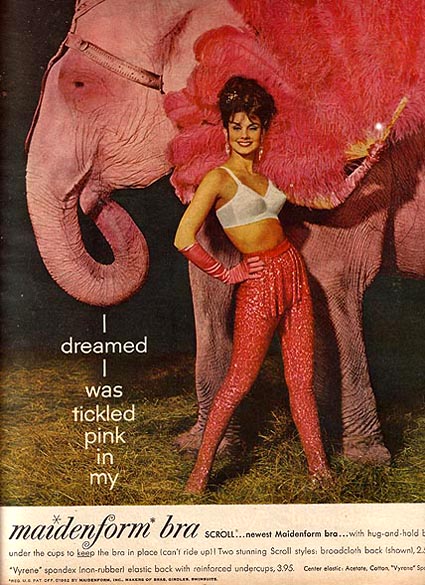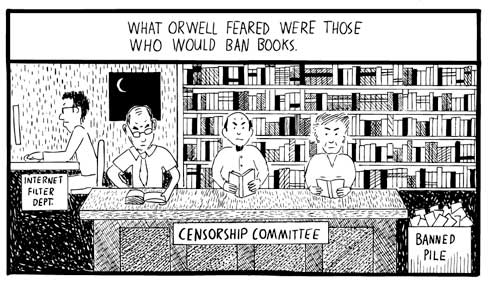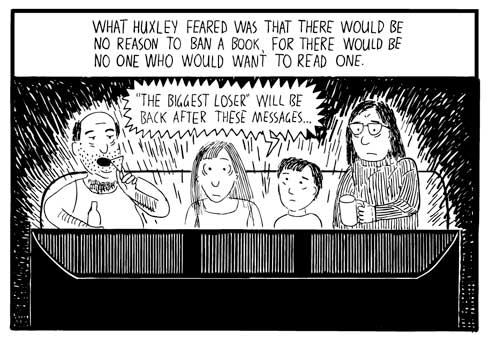I Dreamed I Conquered the World in my Maidenform Bra
January 31, 2010
I rarely remember any of my dreams, unless I’m woken up unexpectedly during the night and I don’t place any stock in them as predictive or even especially insightful. The latest word on them from scientific research is that they are somehow connected with the consolidation of long-term memory. Consistently interrupt someone’s dream cycle and their ability to learn new skills plummets. Click on images for larger size.
Still incompletely understood, dreams may be the by-product of a shuffling and filing system that the brain uses to store information. The symbolic analysis promoted by that cocaine-addicted doctor from Vienna, among many others, has been thoroughly demolished by recent fMRI studies and the explosion of information in brain research in general over the last 15 years. Like anyone ever really believed that a dream about a train going into a tunnel was about fucking.
For some reason I’ve been waking up around 4 or 5:00 am for the past several nights. As a result I’ve been able to recall what I was just dreaming about. Here’s one of them:
I’m a background player on Saturday Night Live in 1977. Buck Henry is the host and we’re rehearsing a sketch about a naive young couple, Buck and Gilda Radner, who’ve walked into an underground head shop, mistaking it for a store selling religious paraphernalia.
The jokes are along the lines of the owner, played by Dan Ackroyd, explaining that the black light poster of Jim Morrison is Jesus before he grew his beard, etc.
 It has the feel of the classic SNL Greek Diner sketch — Cheeburger, Cheeburger, Cheeburger, No Coke, Pepsi — funny in an observational way, without punch lines. When John Belushi pulls out a huge baggie of pot from behind the counter, the “joke” is that you’ll need “a pretty big incense burner” to use up all that incense. Apparently, “a pretty big incense burner” is a running catch-phrase.
It has the feel of the classic SNL Greek Diner sketch — Cheeburger, Cheeburger, Cheeburger, No Coke, Pepsi — funny in an observational way, without punch lines. When John Belushi pulls out a huge baggie of pot from behind the counter, the “joke” is that you’ll need “a pretty big incense burner” to use up all that incense. Apparently, “a pretty big incense burner” is a running catch-phrase.
At one point I ad lib a line, a bold move as I don’t have a speaking part, and Ackroyd and Belushi crack up. My personal comedy gods have smiled on me and I’m in Seventh Heaven. “We’ve got to keep that in, it’s great!” says Danny. Life does not get better than this, I’m thinking.
Running through the sketch for the umpteenth time, Belushi fumbles the ‘pot as incense’ gag and angrily exclaims, “Ah, what the fuck! It doesn’t matter. I’m going to OD on this or something else, anyway.”
For the second time, I speak up and say in a completely straight and somewhat sad voice, “Yes, that’s right. That’s exactly what’s going to happen.” This stops everyone in their tracks. They all look at me uncomfortably, including Belushi. Somehow it’s understood by every person on that stage that what I’ve just said is absolutely true.
 At that moment I wake up and find that I’m crying.
At that moment I wake up and find that I’m crying.
“You Are Not a Gadget” by Jaron Lanier – the first Must-Read book of 2010
January 29, 2010
“Children want attention. Therefore, young adults in their newly extended childhood can now perceive themselves to be finally getting enough attention through social networks and blogs. . . Separation anxiety is assuaged by constant connection. Young people announce every detail of their lives on services like Twitter not to show off, but to avoid the closed door at bedtime, the empty room, the screaming vacuum of an isolated mind.” — Jaron Lanier
I don’t normally seek to force feed my interests and obsessions on others but I’ll make an exception in the case of Jaron Lanier’s You Are Not a Gadget.
If you want to hang with me, you’ve got to read this book. (Just like Eric Clapton who explained that, back in the 1960s, if you didn’t know who Robert Johnson was, he didn’t want to talk to you).
In a just and equitable world You Are Not A Gadget would reach an audience the size of the one for Malcolm Gladwell’s The Tipping Point. As much as I enjoyed Tipping Point, I think this is a more important and profound book. Perhaps Lanier has made a tactical error by subtitling his work as “a manifesto,” a billing that will likely cut down his readership. Personally, I would file this under ‘cogent analysis’ rather than ‘manifesto.’
“. . . popular music created in the industrialized world from the late 1990s to the late 2000s doesn’t have a distinctive style—that is, one that would provide an identity for the young people who grew up with it. The process of the reinvention of life through music appears to have stopped.” — Jaron Lanier
Read this to understand important concepts like “lock-in” as it relates to software development and the “hive mind” aspect of Web 2.0 social media. Find support here if you, like me, can’t stand Twitter and FaceBook.
If you question the recently promoted idea of ‘the wisdom of crowds,’ as I do (strenuously), rest assured that Lanier knocks the intellectual under pinnings of that concept into a cocked hat. I think events like the Internet bubble (and subsequent bust) of the early 2000s and the housing bubble and bust of the late 2000s are great examples of ‘the ignorance of crowds.’ Keep in mind that 50% of the adult American population is below average in intelligence. It’s no surprise that when the majority of them gather online they have nothing interesting, insightful or useful to say.
Read the NY Times review here (quick! before it disappears behind the pay wall) and an essay about it by John Tierny here.
Incredible realistic miniature model landscapes by Matthew Alabanese
January 26, 2010
In stereo photography there is a term, hyper-stereo which means taking two images with a lens separation greater than the normal interocular of about 2.5 inches. Ortho-stereo refers to images taken with a lens separation that approximates the normal human-sized view of the world. Hyper-stereo images are what it might be like to view the world from a giant’s perspective, or even greater.
Two cameras can be set up several feet or even many yards apart to take a landscape view like one of the Grand Canyon. The depth effect is very pronounced but it makes it appear as if we are looking at a miniature model of the Grand Canyon.
None of this has anything to do with the amazing miniature landscapes created out of ordinary materials like sugar, corn syrup, paprika and tile grout by model builder and photographer Matthew Albanese. Except that they remind me of many hyper-stereo views I’ve seen over the years.
Below are two samples of his work showing a Martian landscape and how he achieves a realistic cloud effect with just lighting and cotton wool. For the complete gallery at the Telegraph UK go here. Click on images for larger size.
Pedigree Dogs Exposed – BBC documentary
January 21, 2010
We’ve allowed some breeds to become too heavy, some too short-faced, some too heavy-coated, some too short legged, others too short-lived, all in the pursuit of cosmetic points, not sound anatomical points. — David Hancock, dog historian
The 60 minute BBC documentary Pedigree Dogs Exposed is available for viewing on YouTube in 6 parts. If you care about dogs, it should both sicken and anger you. Watch it directly on YouTube here.
The only conclusion you can come to is that annual dog shows like Crufts and Westminster have degraded our best friends into a parade of deformed, disabled, disease-prone mutants. And we’ve done this in just over 100 years of pursuing a eugenics-based system of standardizing dog breeds to a bizarre, artificial aesthetic that values appearance over health and temperament.
For example, did you know that the distinctive ridge of Rhodesian Ridgebacks serves no useful purpose and is actually a mild of form of spina bifida, the incomplete development of the spinal cord or its coverings? You’ll learn all about this and much more in this riviting exposé. Every caring dog owner should watch it.
Photoshop: Little Known Tips, Tricks & Techniques
January 21, 2010
 We love the folks at Smashing Magazine online. Here they provide a great listing of shortcuts for Photoshop CS4 that even Adobe doesn’t tell you about, “Obscure Photoshop Time-Savers.”
We love the folks at Smashing Magazine online. Here they provide a great listing of shortcuts for Photoshop CS4 that even Adobe doesn’t tell you about, “Obscure Photoshop Time-Savers.”
How Smart is Your Dog?
January 18, 2010
Sarah Kershaw has an excellent article about canine intelligence in the New York Times, “Good Dog, Smart Dog.”
The matter of what exactly goes on in the mind of a dog is a tricky one, and until recently much of the research on canine intelligence has been met with large doses of skepticism. But over the last several years a growing body of evidence, culled from small scientific studies of dogs’ abilities to do things like detect cancer or seizures, solve complex problems (complex for a dog, anyway), and learn language suggests that they may know more than we thought they did. Their apparent ability to tune in to the needs of psychiatric patients, turning on lights for trauma victims afraid of the dark, reminding their owners to take medication and interrupting behaviors like suicide attempts and self-mutilation, for example, has lately attracted the attention of researchers.
Inside Denver’s “Pit Bull Row”
January 18, 2010
Denver has had a breed-specific ban on pit bulls since 1992. In that time 5,286 pit bulls have been impounded and an estimated 3,497 have been destroyed. Shelters in Denver cannot put pit bulls up for adoption; they must try and find room for them in other Colorado cities.
See the photo essay by Joe Tone in Denver Westworld here.
Click on image for larger size.
The Evolutionary Roots of Depression—Scientific American
January 18, 2010
There’s an intriguing story from Scientific American here that raises the possibility that depression should not be thought of as a disorder, but rather an adaptation, “a state of mind which brings real costs, but also brings real benefits.”
The benefit? Deep rumination and thoughtful analysis that may confer a cognitive advantage. Here’s an excerpt:
Analysis requires a lot of uninterrupted thought, and depression coordinates many changes in the body to help people analyze their problems without getting distracted. In a region of the brain known as the ventrolateral prefrontal cortex (VLPFC), neurons must fire continuously for people to avoid being distracted. But this is very energetically demanding for VLPFC neurons, just as a car’s engine eats up fuel when going up a mountain road. Moreover, continuous firing can cause neurons to break down, just as the car’s engine is more likely to break down when stressed. Studies of depression in rats show that the 5HT1A receptor is involved in supplying neurons with the fuel they need to fire, as well as preventing them from breaking down. These important processes allow depressive rumination to continue uninterrupted with minimal neuronal damage, which may explain why the 5HT1A receptor is so evolutionarily important.
How might this impact on therapies and treatment for depression?
. . .depression is nature’s way of telling you that you’ve got complex social problems that the mind is intent on solving. Therapies should try to encourage depressive rumination rather than try to stop it, and they should focus on trying to help people solve the problems that trigger their bouts of depression. (There are several effective therapies that focus on just this.)
Huxley vs. Orwell: Whose Vision of the Future Are We Living In?
January 18, 2010
Aldous Huxley is one of the few writers whose entire published output I’ve read. (Others include A.J. Liebling, Dorothy Parker, Raymond Chandler & Dashiell Hammett). I’ve also read a good deal, though not all of, the work of Eric Blair (George Orwell).
Between them Orwell and Huxley wrote the two classic dystopian novels of the last century, 1984 and Brave New World. As much as I admire Orwell, I believe that Huxley came much closer to being prescient as this cartoon piece, “Amusing Ourselves to Death” by Stuart McMillen shows. This is Neil Postman’s argument (from his book of the same name) given graphic form.
Why a High IQ May Not Correlate with “Intelligence”
January 18, 2010
I took an I.Q. test 30 years ago and was flattered to learn that I scored 140 points. But in all honesty, if I look back over those three decades I must admit to making some pretty foolish decisions. How could that be, doesn’t that number prove I’m supposed to be “smart”?
New Scientist has a fascinating article by Michael Bond that explains this apparent paradox, Clever Fools: Why a High IQ Doesn’t Mean You’re Smart.
“Think of our minds as searchlights. IQ measures the brightness of the searchlight, but where we point it also matters. Some people don’t point their searchlights at the other side of the case much, for many reasons – entrenched ideas, avoidance of what might be disturbing, simple haste. A higher wattage searchlight in itself is no protection against such follies.” — David Perkins, Professor of Teaching and Learning at the Harvard Graduate School of Education
“Even the super-intelligent are not immune,” writes Bond. “A survey of members of Mensa (the High IQ Society) in Canada in the mid-1980s found that 44 per cent of them believed in astrology, 51 per cent believed in biorhythms and 56 per cent believed in aliens.”
So how can we avoid making foolish decisions? Bond offers these six maxims:
- Clear Your Mind
- Don’t Fall Foul of Spin
- Don’t Let Emotions Get in the Way
- Be Fact Based
- Think Carefully About the Long-Term Consequences
- Look Beyond the Obvious Solution
These may all seem like plain common sense. But if we examine the financial decisions that led to the current Great Recession it’s easy to see that a great many people failed to use these very practical principles. Proving again that there is nothing common about common sense.







